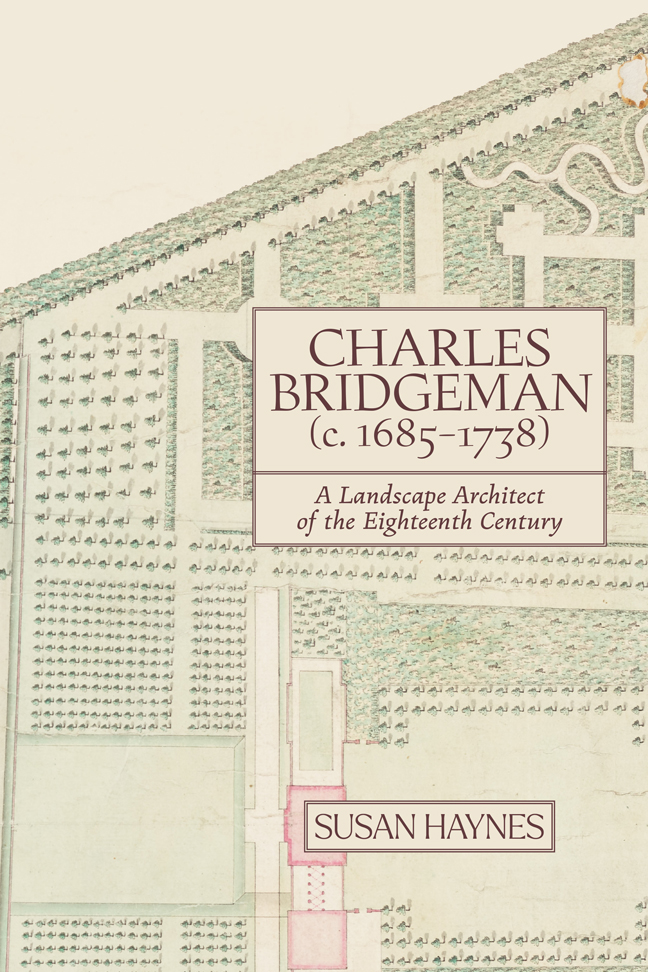Book contents
- Frontmatter
- Dedication
- Maps
- Contents
- List of Illustrations
- Acknowledgements
- List of Abbreviations
- Introduction
- Chapter 1 Who Was Charles Bridgeman?
- Chapter 2 Towards A Reliable Corpus
- Chapter 3 A Revised Catalogue
- Chapter 4 Reading The Plans
- Chapter 5 The Art-Historical Context Revisited
- Chapter 6 The ‘Ingenious Mr Bridgeman’
- Chapter 7 Building a Landscape
- Chapter 8 A Commercial Enterprise
- Conclusion
- Appendix I A summary of Willis's catalogue from Charles Bridgeman and the English Landscape Garden
- Appendix II A revised catalogue
- Appendix III Bridgeman's projects by year
- Appendix IV Bridgeman's income
- Gazetteer of Bridgeman sites
- Glossary
- Bibliography
- Index
- Miscellaneous Endmatter
Chapter 3 - A Revised Catalogue
Published online by Cambridge University Press: 21 February 2024
- Frontmatter
- Dedication
- Maps
- Contents
- List of Illustrations
- Acknowledgements
- List of Abbreviations
- Introduction
- Chapter 1 Who Was Charles Bridgeman?
- Chapter 2 Towards A Reliable Corpus
- Chapter 3 A Revised Catalogue
- Chapter 4 Reading The Plans
- Chapter 5 The Art-Historical Context Revisited
- Chapter 6 The ‘Ingenious Mr Bridgeman’
- Chapter 7 Building a Landscape
- Chapter 8 A Commercial Enterprise
- Conclusion
- Appendix I A summary of Willis's catalogue from Charles Bridgeman and the English Landscape Garden
- Appendix II A revised catalogue
- Appendix III Bridgeman's projects by year
- Appendix IV Bridgeman's income
- Gazetteer of Bridgeman sites
- Glossary
- Bibliography
- Index
- Miscellaneous Endmatter
Summary
THE BUSINESS OF creating a more reliable corpus of Bridgeman's work begins with the 101 plans in Peter Willis's catalogue (shown in Appendix I). His carefully curated list provides a very useful, if not totally secure, base line. Investigating the provenance of the plans Willis lists, examining their graphic style closely and finding out whether we can say with any certainty that Bridgeman worked at the site, allows us to cast a critical eye over the contents of the catalogue. What this immediately shows up is that there are some plans, although not many, which have found their way into Willis's corpus erroneously. There is also a group of drawings which Willis has omitted from his catalogue, but which should be included. Using the same criteria of provenance, style and presence, close study of a number of plans, some perhaps not seen by Willis, some identified by academic sources, suggests they are probably by Bridgeman. Of course, as pointed out in Chapter 2, their inclusion or rejection will always be a matter of judgement rather than fact, and so the resulting revised corpus (Appendix 2) may well be contentious.
We might deal first with the removals. Some plans in Willis's catalogue are unequivocally by another author. Work 32/96, in the National Archives, which depicts Richmond Gardens, is actually in Willis's category ‘B’ – ‘probably’; he suggests it ‘reveals how the Royal Gardener proposed to loosen the outline of fields and replace clumps by wavy belts of trees’. It is, in fact, identified as being by Lancelot Brown in Dorothy Stroud's 1984 biography of him (Stroud 1984a, 128 n. 12), although Brown is not identified as its author in the National Archives catalogue (http://discovery.nationalarchives.gov.uk). The plan of Kensington Gardens, K. Top XXVIII 10 d.1, in the British Library, is in a bound volume, and is followed, on the next page, by K. Top XXVIII 10 d.2, ‘A Survey and particular Admeasurement of the Royal Gardens at Kensington’, two pages detailing the acreages of parcels of land in Kensington Gardens. Although it is painted in colours characteristic of Bridgeman, it is, as suggested by the contemporary title page which immediately precedes it in the bound volume (catalogued as K Top XXVIII 1.c), a survey by Joshua Rhodes dated 1762, and engraved in 1764 by George Bickham;
- Type
- Chapter
- Information
- Charles Bridgeman (c. 1685-1738)A Landscape Architect of the Eighteenth Century, pp. 45 - 60Publisher: Boydell & BrewerPrint publication year: 2023

